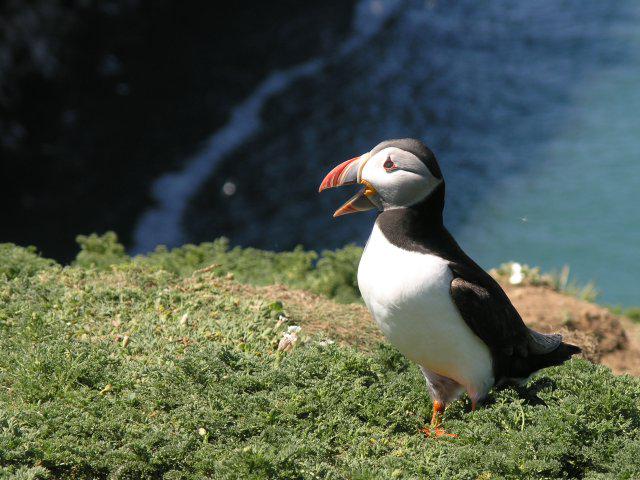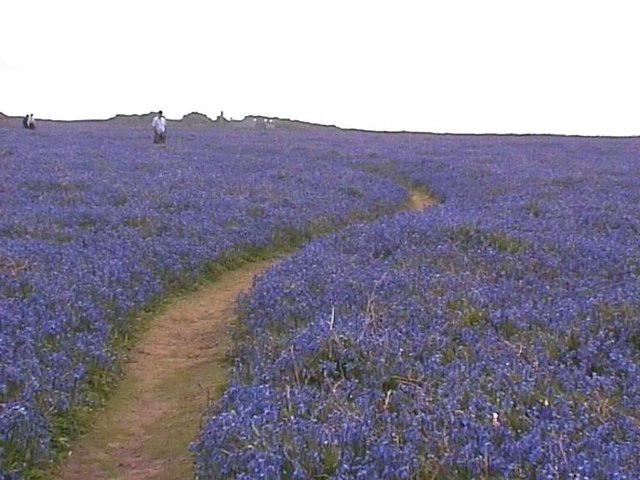Skomer (Welsh: Ynys Sgomer) is an island off the coast of Pembrokeshire.
 One of the finest wildlife sites in the UK, Skomer is an island of around 2 × 1½ miles (3 by 2 km), lying around ½ mile off the Pembrokeshire coast near Marloes. It is best known for its colonies of breeding seabirds, notably Puffins and Manx Shearwaters. Day trips by boat are available but visitors can also stay in self-catering accommodation on the island (highly recommended for a peaceful and relaxing experience). The neighbouring smaller island of Skokholm has a bird observatory and also offers day trips (though not in 2013) and basic accommodation.
One of the finest wildlife sites in the UK, Skomer is an island of around 2 × 1½ miles (3 by 2 km), lying around ½ mile off the Pembrokeshire coast near Marloes. It is best known for its colonies of breeding seabirds, notably Puffins and Manx Shearwaters. Day trips by boat are available but visitors can also stay in self-catering accommodation on the island (highly recommended for a peaceful and relaxing experience). The neighbouring smaller island of Skokholm has a bird observatory and also offers day trips (though not in 2013) and basic accommodation.
Skomer shows evidence of inhabitation back to the Iron Age, including stone circles and the remains of prehistoric houses. Its last permanent inhabitants left in the 1950s. The island is managed by the Wildlife Trust of South and West Wales (previously the West Wales Field Society) and opened for visitors in April 1946.
Skomer is largely covered in treeless heathland, grazed by rabbits, with isolated granite outcrops. It is surrounded by high sea cliffs.
 Skomer is probably most famous for its breeding seabirds, most notably Puffins and Manx Shearwaters. Both birds nest in burrows; the latter spend the day at sea and return only under cover of darkness, so day visitors will be fortunate to see them, but close-up views of Puffins are guaranteed in season (April–July). Other breeding birds include Razorbill, Guillemot, Chough and Short-eared Owl. In spring and autumn the island can attract rare migrant birds.
Skomer is probably most famous for its breeding seabirds, most notably Puffins and Manx Shearwaters. Both birds nest in burrows; the latter spend the day at sea and return only under cover of darkness, so day visitors will be fortunate to see them, but close-up views of Puffins are guaranteed in season (April–July). Other breeding birds include Razorbill, Guillemot, Chough and Short-eared Owl. In spring and autumn the island can attract rare migrant birds.
Skomer is also known for its flowers, notably the carpet of bluebells and red campions in May and June. It has its own unique subspecies of mammal, the Skomer Vole (Clethrionomys glareouls skomerensis), a subspecies of the Bank Vole.
The sea around the island is rich in marine life (the area is a statutory Marine Nature Reserve, one of only three in the UK). Seals, porpoises and dolphins can be seen, with patience or luck, from the island.

- Seabird colonies
- Seals and porpoises. Keeping your distance is strongly advised; see Dangerous animals.
- Flowers
- Iron Age remains
- Spectacular cliff scenery
Taking good photos of birds or other wildlife will almost certainly require a telephoto lens.
There is no traffic, no television, no nightlife, no internet and variable mobile signal on the island—and that is the whole point. The sheer lack of things to do, other than walking and wildlife-watching, makes for a relaxing getaway and the peace and beauty of the place is a real natural tonic. (On the other hand, it could be a bit grim if the weather forced you to stay inside.)
If staying overnight in April–July, a night walk to see and hear the amazing spectacle of the Manx Shearwaters returning to their burrows is a must.
There is no restaurant, pub, café on the island. All visitors must bring their own provisions.
There are no shops on the island.
